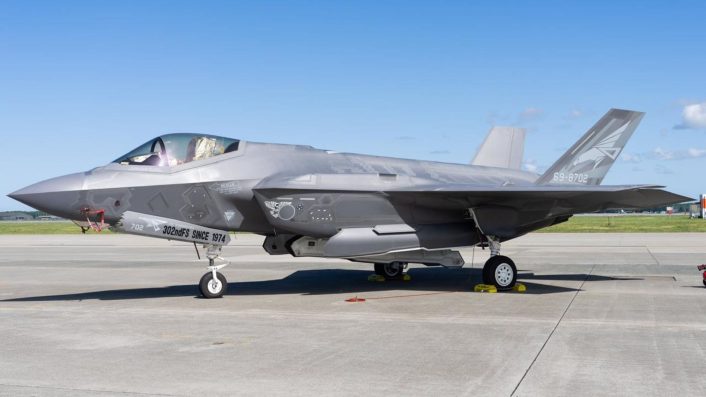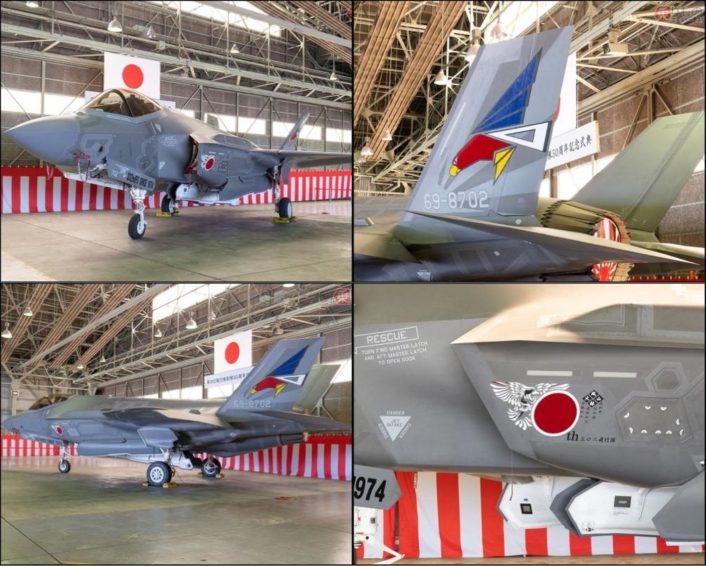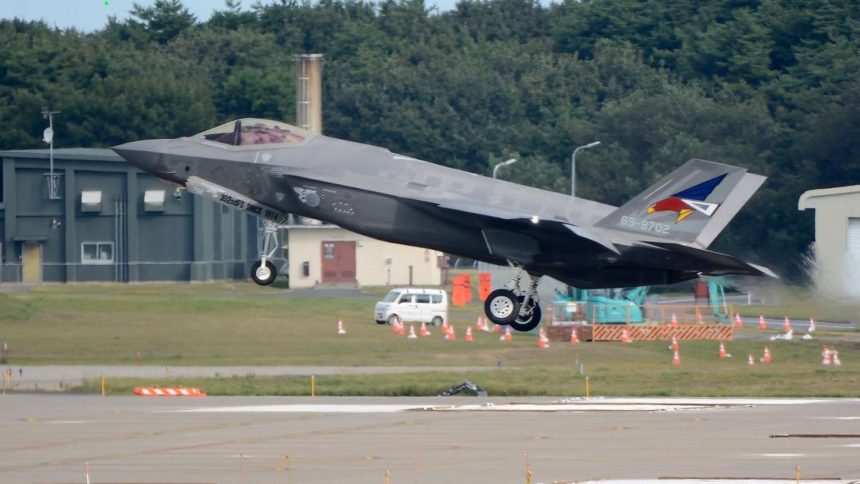The 302nd Squadron chose a local species of eagle as its mascot, native to the mountains around its home base in Misawa, called Ojirowashi (white-tailed sea eagle). Japan has a tradition of painting its fighters like the aggressor F-15s and the retired F-4s in vibrant, striking and the most artistic livery, with a diverse combination of color combinations and designs, making them a sight to behold.
The JASDF’s (Japan Air Self-Defense Force) 302nd Squadron (or 302 Hikotai) unveiled an F-35A Lightning II in a unique, vibrant color scheme for the first time at Misawa Air Base, in the country’s north. The F-35A, serial number 69-8702, sported a colorful bald eagle emblem in a yellow-vermilion red-white-blue paint scheme.
The images and the information were posted on the Avia News Telegram channel, noting this was on the occasion of the squadron celebrating its 50th anniversary. The 302 Hikotai was, in fact, formed on Oct. 1, 1974 at Chitose Air Base in Hokkaido as the second of the JASDF’s Phantom squadrons.
While no official information was released by the JASDF on either the ceremony or the paint job, some pictures of the fighter with the new paint were captured by Japanese aircraft spotters around the air base and also shared on X. The colored logo, an eagle, its wings and its talons, had been standard across the squadron’s older F-4EJ Phantom IIs.
The F-35s of the squadron received the same eagle emblem on the tail, but in the jet’s standard light and gray scheme. The new colors filled the empty spaces in the eagle’s design for it to stand out. However, with the reduced number of colored paints approved for the fighter to preserve its low visibility, it is likely the paint would be removed soon and the jet reverting back to standard color scheme.

The F-35A and the paint job
According to open source aircraft registries, the F-35A in question, serial number 69-8702, was manufactured at the LMTAS (Lockheed Martin Aircraft Systems) plant in Fort Worth, Texas, and took its first flight on Nov. 30, 2016. The JASDF’s 302 Hikotai itself was reformed on Mar. 26, 2019, at Misawa Air Base, during a ceremony to mark its transitioning from the F-4 Phantom.
平成31年3月26日(火)、
三沢基地で第302飛行隊新編行事が行われました。🌸🎶🎉
新時代とともに歴史を紡いでいきます#航空自衛隊#三沢基地#第302飛行隊新編行事 pic.twitter.com/MOkR3Z2Iga
— 航空自衛隊 三沢基地 (@jasdf_misawa) March 26, 2019
At the time, an F-35A flew with two of the older Phantoms from the 302 Hikotai. One of the F-4s could be seen with the same tail logo and color combination. Interestingly, Misawa Air Base was also the location to receive the JASDF’s first F-35A (89-8706) on Jan. 26, 2018, according to a release from the U.S. Air Force. The service’s 35th Fighter Wing is also based there.
Japan has a long tradition of painting its fighters in vibrant and striking livery, seen in its ‘aggressor’ F-15s, with a diverse combination of color combinations and designs, making them a sight to behold. As will be explained subsequently, the same holds for its F-4s. The Aviationist had reported how in June the JASDF repainted one of its F-15J/DJs (airframe 12-8074) from the Flight Training Group (or the ‘Hiko Kyodogun) at Komatsu Air Base, with a new camouflage paint scheme.

Interestingly, Avia News also shared a collage of images showing additional paint jobs on 69-8702’s air inlets’ exterior, showing the JASDF roundel having the red color (not seen in the other pictures) and eagle’s wings behind it brightened with white paint and a black outline.
However, pictures shared on X by aircraft spotter ‘ASASHIN/shin_f_eagle’ showed only the tail coloring and not the changes to logo on the inlets. The handle nevertheless shared pictures of 69-8702 from both the left and the right side, showing the eagle on both the tails receiving the new paint. A retweeted comment by another Japanese handle said it “wasn’t even finished when it was displayed at the airshow.”
今日はデカオジロに驚かされました✨
左側撮ったら右側も撮らなきゃ…なので結構な雨の中降りてきたデカオジロの右側もご覧下さいませ。 pic.twitter.com/1jyv8Gg9AJ
— ASASHIN (@shin_f_eagle) October 2, 2024
This suggests that the coloring on the nacelles was done after the ceremony and the photographs in the collage were captured following that event. As mentioned earlier, there has been no official information on the ceremony or the new paint scheme, but the plane spotters confirm the original report. Finer details on when the paint job was done and first displayed are still unclear.
JASDF 302 Hikotai’s Tail Markings
According to J-HangarSpace, which documents histories and photographs of JASDF squadrons, the 302 chose a species of eagle as its mascot, that is native to the mountains around its home base in Misawa. It is called Ojirowashi (white-tailed sea eagle). The design actually represents the unit’s number – the wing stands for ‘3’, the tail represents ‘0’, and the talons symbolize ‘2’.
#全日本バリ順選手権 pic.twitter.com/tWM3yCGNt3
— ルーシー(旧名 Lusty11) (@lusty_11) September 15, 2020
All the squadron’s F-4s sport the most vivid, diverse, artistic and spectacular paint schemes around the airframe but have the same tail marking and the color scheme reintroduced for this particular F-35A (69-8702) in the interest of tradition. These range from full airframe designs, to only nose art of shark mouths and dragon heads and possibly every combination of the two in a range of colors.
#飛行機を3機一緒に撮りました pic.twitter.com/72DpYvAAFc
— aya01@生きてるだけで儲けもの (@aya01flt) October 4, 2024
J-HangarSpace also added since its F-4 days, the 302 Hikotai was also the sole JASDF squadron that was exempt from the standard rule requiring the tail marking to be toned down and smaller in size than the ‘hinomaru’ national marking (or the roundel).









